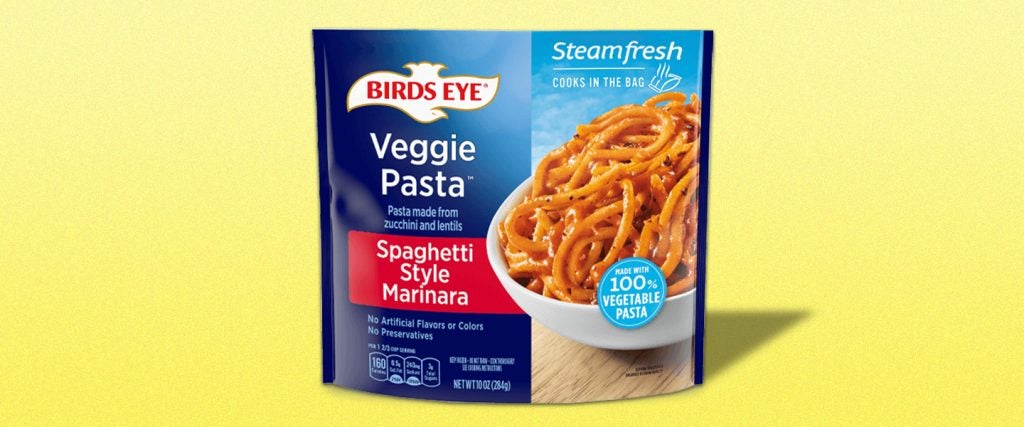Even if only for purposes of psychological self-manipulation, veggie pasta is a masterful invention. Think about it: Why go through the difficulty of chopping up vegetables to add to your pasta or your spaghetti sauce when your pasta is a vegetable? It’s brilliant.
On a personal note, veggie pasta just happens to be one of the most common sights at our family’s dinner table. It comes prepackaged in easily microwaved bags, and makes me feel like I’m consuming sufficient vegetable servings even if they’re administered in a decidedly non-vegetable form.
But am I simply misleading myself by believing that veggie pasta is actually healthy? The answer to that question is a bit more complicated that it might seem.
Why is it so complicated? They’re just vegetables, right?
I‘m fully aware of what the label on the package says, and yet I’m also aware that in order to turn one healthy food into a satisfactory substitute for something that’s ostensibly less healthy, the standard tactic has been to essentially recreate the replaced item by using the unhealthiest portions of the source material. This is precisely what happens with turkey bacon and chicken sausages, so I’m a little more cautious and skeptical going into this investigation than I’d ordinarily be.
First of all, let’s leave all thoughts of vegetables completely out of it and see how well veggie pasta functions as a pasta by comparing pre-packaged frozen Birds Eye Spaghetti Style Marinara veggie pasta to its non-veggie equivalent, Michelina’s Spaghetti Marinara.
Ingredients of Birds Eye Spaghetti Marinara: Cooked lentil zucchini spaghetti style pasta (water, lentil flour, zucchini), water, tomato paste, olive oil, onions, sugar, salt, garlic puree, basil, cornstarch, cooked mushrooms, mushroom extract, spices, natural flavoring, canola oil, potato flour, sea salt, onion powder
Ingredients of Michelina’s Zap ‘ems Spaghetti Marinara: Cooked enriched macaroni product (water, durum wheat semolina, wheat flour, niacin, ferrous sulfate, thiamine mononitrate, riboflavin, folic acid), water, tomato paste, canola oil, sugar, salt, modified food starch, granulated onion, granulated garlic, spices, xanthan gum, yeast extract
Honestly, it’s a credibly comparable list of ingredients, with the most drastic differences being in the composition of the pasta itself; the veggie pasta is made of lentil flour and zucchini instead of wheat and other enriched flour materials.
Now, in order to make a proper comparison between the nutrients, we have to equalize the serving sizes. Since the veggie pasta has a suggested serving size of 114 grams and the regular pasta’s serving size is 213 grams, we’re going to amplify the veggie pasta’s stats to reflect a 213-gram serving size.

As you can see, the veggie pasta is more caloric, but respectfully so. After all, if this is intended to be a side dish as part of a larger dinner, 300 calories is a very reasonable sum. Moreover, the veggie pasta still has less sodium, and is far more nutritionally balanced between its three macronutrients. All things considered, Birds Eye’s veggie pasta is a potent replacement for the standard fare.
That’s cool, but how does the veggie pasta perform as a vegetable?
That’s a little bit more complicated, but I’ll give it a shot.
I’m gonna assume that you consumed this cooked lentil-and-zucchini pasta in lieu of consuming ordinary pasta or half a zucchini and half a cup of lentils. One of the benefits to eating a zucchini would ordinarily be its high vitamin C content, but the cooking process would cause that vitamin C to leach out into the water due to its water solubility. You would still benefit from the presence of around 250 milligrams of potassium, which the veggie pasta retains.
The half cup of lentils would also have had its vitamin B and C stripped away, leaving behind a high-protein item with a decent amount of iron and a further 300 milligrams of potassium. Birds Eye’s veggie pasta has more than 900 milligrams of potassium per serving, and nearly twice the iron of half a cup of lentils. In essence, it could be argued that veggie pasta packs nearly double the nutritional potency of an entire cooked zucchini and a full cup of cooked lentils.
Now, is veggie pasta nutritionally superior to raw lentils and raw zucchini? Probably not, but this exercise is all about making fair comparisons. With the evidence on hand, not only is it fair to say that veggie pasta is healthy in comparison to the pasta that you might otherwise serve, but it respectfully fills in for the similarly prepared vegetables that you might have served in its place.
Who says a healthy food has to become unhealthy in order to fill in for a less healthy food? Not me. Not anymore.

